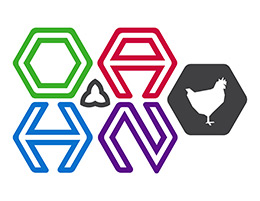Ontario Animal Health Network (OAHN)
Poultry Expert Network
Quarterly Producer Report
Infectious Bronchitis Virus (IBV) and Infectious Bursal Disease Virus (IBDV) strains – By Commodity (Dec 2020 – Nov 2021)
Emily Martin, Avian Pathologist, Animal Health Laboratory, University of Guelph
In the OAHN year running from December 2020 to November 2021 the following tables show sequencing data from the AHL Virology lab for Ontario cases of IBV and IBD. The most common field strains are highlighted. DMV is the most common IBV strain for all 3 chicken commodity groups. The most common IBDV strain is PA105-2014 followed by NC171.
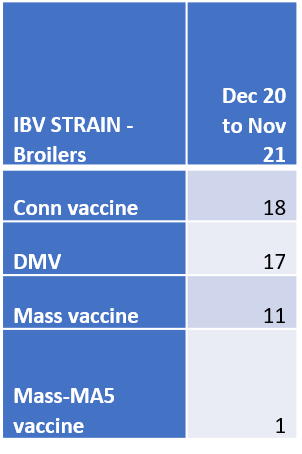
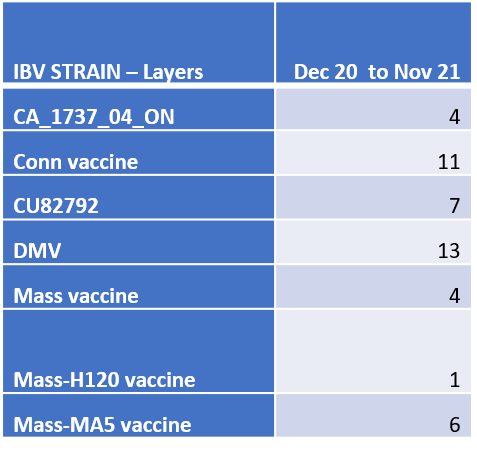
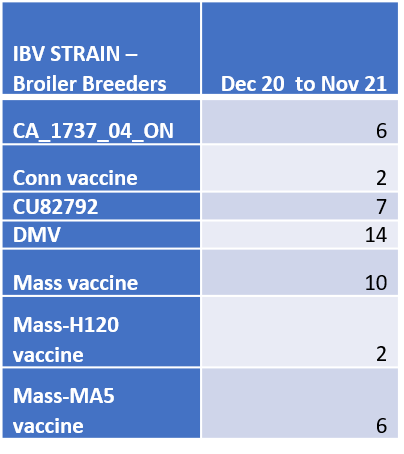
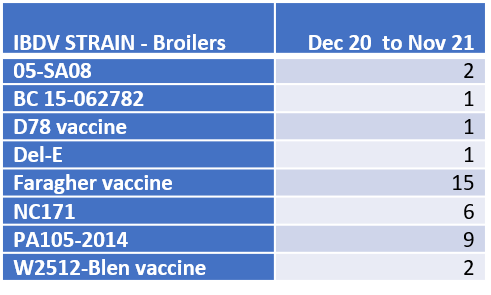
Poultry Veterinarian Survey Highlights – Q4 2021
Broilers
NOTE: Although detected after this quarter, it should be noted that ILT was detected in a commercial broiler flock in December 2021.
Early systemic bacterial infections (<14 days) were generally stable to slightly increased this quarter as reported by practitioners. Escherichia coli, E. cecorum and Clostridium were identified by practitioners. The AHL reported confirmed cases due to mixed infection of E. coli with or without E. cecorum, P. aeruginosa, S. aureus and Clostridium perfringens. One practitioner reported Salmonella Thompson on environmental testing.
Other causes of early mortality (<14 days) were reported as stable by practitioners and AHL.
Late systemic bacterial infections (>14 days) were reported as stable to increased by practitioners. E. coli, Enterococcus cecorum and Clostridium sp were the main bacteria isolated. AHL reported stable numbers of cases attributed to E.coli alone or in various combinations with E. cecorum, S. aureus, S. Enteritidis or C. perfringens (this bacteria has been detected in the past 3 quarters and continues to be monitored). Practitioners reported 6-40% of E. coli isolates have been resistant to Trimethoprim sulfa (TMS).
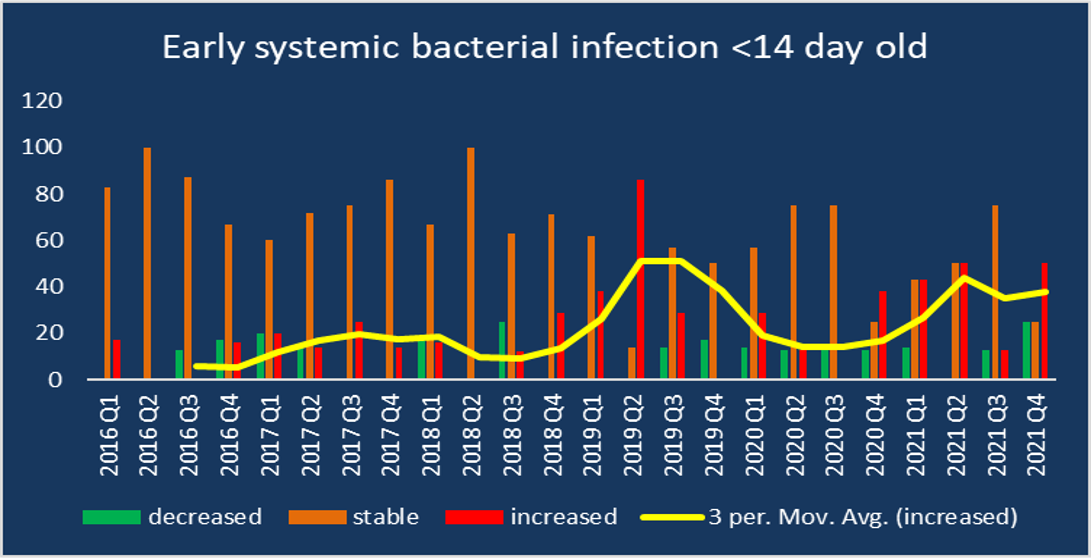
The number of cases of nutritional and developmental lameness were reported as stable by most responders. Rickets (calcium/vitamin D or phosphorus deficiency) being noted as diagnoses by practitioners. AHL also reported 1 case of tibial dyschondroplasia.
Bacterial lameness was reported as stable to slightly increased for this quarter and was attributed to E. coli and E. cecorum, alone or in combination. AHL reported increased bacterial osteomyelitis and tenosynovitis. E.coli, E. cecorum, S. aureus, S. gallolyticus and S. Enteritis were isolated from case of osteomyelitis. Tenosynovitis cases were primarily diagnosed on histopathology.
Reovirus-associated lameness cases were reported stable by practitioners and AHL reported a decrease in confirmed cases. As usual, a variety of strains were detected but strain SK_R38 was not detected despite being detected in larger numbers in the previous 2 quarters. Also, it has been noted by AHL that variant E (last identified in Q1 of 2019) increased in the number of detections this quarter.
Infectious bursal disease virus (IBDV) infections were reported as stable to increased this quarter by practicing veterinarians and increased by AHL. This increase may be partially related to increased testing. Practitioners reported the main strain to be Pennsylvania (USA PA105-2014 field strain) affecting performance and weight gain. AHL recommended more sequencing and histology when this virus is detected.
Inclusion body hepatitis (IBH) cases were reported to be stable compared with last quarter by most respondents and AHL. Genotyping on confirmed cases identified mainly FAdVE of the species E viruses in birds both <14 days and >14 days old as well as different combinations of FAdVAC, FAdVE and FAdVD. AHL reported primarily FAdV08b (<14 days and >14 days old) as well as 1 case of FAdV11 in birds >14 days old.
Ascites was reported as stable by practitioners this quarter.
Coccidiosis and necrotic enteritis cases were reported as stable to slightly increased by the practitioners. The AHL also reported decreased coccidiosis cases, identifying the lesions in the small intestine, ceca or both.
Condemnation issues were reported as stable by veterinarians this quarter and included cellulitis, air sacculitis, necrotic hepatitis, pendulous crop and PDS (Proventricular Dilation Syndrome).
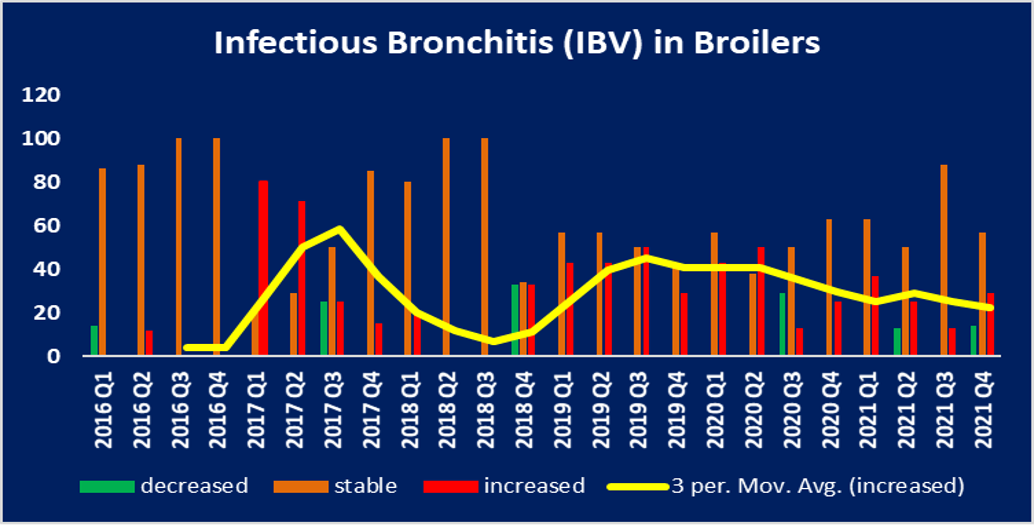
The number of flocks with infectious bronchitis virus (IBV) were reported as stable to slightly increased this quarter by the majority of poultry practitioners and AHL. The DMV and California field strains as well as the Mass MA5 and Conn vaccine strains were identified by AHL.
Submissions to the AHL of confirmed runting and stunting syndrome (RSS) caused by astrovirus were stable this quarter. AHL reported 10 compatible and 8 suspect lesions in broilers at <14 days of age and 3 compatible and 5 suspect lesions in broilers >14 days of age.
Practitioners reporting the impact of RSS identify persistent challenges including: uneven flock weights, wet litter, increased culling, increased mortality rate, poor feed conversion, poor weight gain, and higher condemnation rate at processing. Financial losses are also incurred when small birds are not shipped to processing. It seems that a few farms are consistently affected. In the clinical opinion of practitioners, the risk factors could include: high stocking density, brooding set up, feed and water consumption , environmental factors (lighting, CO2, air quality), infections with enteric viruses, immunosuppression (e.g. IBD), and short downtime between flocks.
Proventricular and ventricular lesions were reported as stable by AHL with 4 proventricular dilations, 6 ventricular lesions and 8 proventriculitis/adenitis
Other histology findings reported by AHL were: mycotic pneumonia, liver hemorrhage, thymic lymphoid depletion (1 CAV positive), heat stress and 2 cases of encephalomyelitis (thought to be vaccine related).
Broiler-Breeders
Early systemic bacterial infections (<14 days) with and without associated yolk sacculitis were reported as stable by practitioners. AHL reported that E. coli continues to be the most common isolate either alone or in combination with Enterococcus cecorum or Gallibacterium anatis. Practitioners also mention isolation of Pseudomonas aeruginosa. One practitioner reported early septicemia with Escherichia coli, Enterococcus cecorum and Clostridium sp. 4-5 days after placement causing close to 15% mortality.
Pre-lay mortality (> 14 days, < 20 weeks) reported by practitioners and identified by AHL were due to E. coli alone or in combination with Enterococcus cecorum. One practitioner reported a case where the Clostridium infection seemed to affect lungs first then liver leading to necrosis.
Other causes of early mortality reported by practitioners and AHL were stable this quarter and included dehydration as well as necrosis of the beak and oral mucosa.
In-lay bacterial septicemia was reported as stable to slightly increased by practitioners. Similarly, AHL reported septicemia due to E.coli, S. aureus, E. cecorum, G. anatis and C. perfringens in various combinations. C. perfringens seems to be more prevalent with other underling issues. Practitioners are reporting a slight increase in cases of multi-drug resistant E. coli.
Cellulitis/ dermatitis diagnosed at AHL was attributed to S. aureus, E. coli and G. anatis.
Bacterial, viral, development and nutritional lameness was reported as stable by practitioners for this quarter. S. aureus was the most common bacterial cause of lameness reported by practitioners and AHL. There were also some mixed infections with 2 or more of the following bacteria: S. aureus, E. coli or E. cecorum.
IBV infections with decreased production and abnormal eggs were reported as stable to decreased by the practitioners and at AHL. The main strains detected were: CU82792, DMV, California, and vaccine strains (H120, MA5).
The number of coccidiosis and necrotic enteritis cases reported by practitioners were stable to decreased this quarter. One practitioner related that coccidiosis is frequently seen in flocks with high bacterial challenges. AHL reported a slight decrease in both necrotic enteritis and coccidiosis affecting the small intestine and ceca. The slight increase in E. necatrix cases at AHL may be due to adapting coccidiosis management to a change in vaccine.
Histomoniasis remained stable as reported by practitioners. One practitioner reported observing more Heterakis on routine fecal exams (can carry Histomonas).
There were more cases of aggression and cannibalism reported in male lines.
A suspect case of White chick syndrome (WCS) was reported by one practitioner.
An increase in positive results for Mycoplasma synoviae was reported by one practitioner.
Poultry practitioners reported a variety of Salmonella isolates including S. Livingstone, S. Hadar, S. Kentucky, S. Kiambu, S. Putten and S. Mbdanka.
AHL reported also reported cases of granulomatous and fibrinoheterophilic pneumonia (E. coli, E. cecorum, S. aureus), deep pectoral myopathy, salpingitis (E. coli with or without G. anatis) and liver hemorrhage.
Layers
Overall, good health status for this quarter.
Bacterial peritonitis/salpingitis due to E. coli, and E. cecorum was stable to increased as reported by practitioners.
Early systemic bacterial infections (<14 days) were stable for this quarter.
Cases of pre-lay mortality (>14 days, < 20 weeks) at AHL identified E. coli septicemia and a case suspicious for Avian Encephalomyelitis due to a vaccination reaction.
One case of ionophore toxicity was reported by a practitioner.
Focal duodenal necrosis (FDN) was reported as stable to decreased by practitioners.
IBV was reported as stable to decreased by practitioners and AHL. Additional samples submitted to AHL Virology identified various strains including: CU82792, DMV, California and vaccine (Mass H120, Mass MA5, Conn) strains. Practitioners reported that IBV due to DMV, CU82792, and California strains caused reduced feed and water intake in young pullets. Recovery can take 7-14 days and killed vaccine is noted to aid in recovery. Most flocks returned to normal feed intake but some did not, resulting in reduced egg production.
Necrotic enteritis and coccidiosis cases were reported as stable to decreased by practitioners and AHL.
Intestinal parasitism due to roundworms was noted as an ongoing issue in aviaries.
Other AHL diagnoses included: mycotic airsacculitis and pneumonia (Aspergillus spp. and Penicillium sp.), septicemia (E. coli, E. cecorum), fatty liver, vent trauma/prolapse/ cloacitis, and peripheral neuritis.
Turkeys
Early systemic bacterial infection <14d were stable to decreased.
On bacterial culture, E. coli in combination with E. cecorum, P. aeruginosa, S. gallolyticus or S. Albany were isolated by AHL.
Other causes of early mortality <14d were stable this quarter.
Late systemic bacterial infection >14d were stable.
One practitioner reported a case of E coli septicemia
with large dark spleens in 3-4 week old poults.
AHL reported isolation of E.coli alone or in combination with other bacteria (Streptococcus gallolyticus, S. Muenchen).
Practitioners reported stable to increased mycotic respiratory disease and AHL reported an increase (4 cases) in mycotic pneumonia. One of the mycotic respiratory conditions was thought to be due to poorly stored, damp shavings used as bedding as a common source. Straw is still considered to pose a bigger risk for mycotic infections.
ORT was reported as stable by practitioners.
AHL reports an increase in detection of Streptococcus gallolyticus in conjunction with mixed infection.
Necrotic enteritis and coccidiosis were reported as stable to increased by practitioners. It was also noted that poults affected at 3 weeks of age take longer to respond to treatment.
Enteritis was reported as stable this quarter by practitioners.
AHL reported cases of rickets, chondrodystrophy, cellulitis and adenovirus.
Veterinarians and AHL reported tenosynovitis due to reovirus was stable to decreased this quarter. AHL confirmed 1 case by PCR and 1 by histopathology.
Aggression and cannibalism were reported as stable to increased by practitioners.
Histomoniasis (blackhead) was reported as stable to slightly increased. Three cases were confirmed by AHL. One practitioner reported a repeat case on a farm starting at 10-11 weeks of age. Mortality decreased when stocking density was reduced after lighter hens were shipped, Biosecurity is important to avoid moving the parasite between barns and between farms.
Poultry practitioners reported a variety of Salmonella isolates including S. Albany and S. Ouakam.
Rural/Backyard/Non-Quota Flocks
AHL continues to receive increasing submissions from backyard flocks. The number of backyard/urban poultry has increased due to COVID-19. The majority of cases include various breeds of chickens.
A slight decrease in intestinal parasitism was reported by AHL with primarily coccidiosis (small intestine and ceca)including E. necatrix reported. Nematodes (Ascaridia and Heterakis) were also identified.
Marek’s disease continues to be diagnosed and has increased in numbers compared with the third quarter (13 vs 8 cases)
Four cases of ILT were diagnosed by AHL in small/exhibition flocks: 2 Niagara-like field strain CAGG cluster, 1 USA vaccine-like strain TCAA cluster, and 1 unable to sequence.
Salpingitis was diagnosed in 2 cases. One case had E. coli and Avibacterium sp. identified.
Cases of septicemia identified a variety of bacteria in pure culture: E. coli, Erysipelothrix rhusiopathiae, and Avibacterium paragallinarum.
AHL reported a large variety of diagnoses: IBV (histology and PCR positive), Knemidocoptes mutans, necrotic enteritis (C. perfringens), emaciation, necrotizing sinusitis, anterior uveitis, otitis media, liver hemorrhage, visceral gout, scavenger attack, as well as periesophageal cellulitis and abscessation.
Other species examined at AHL included: One guinea fowl case with no diagnosis. One duck case with multiple diagnoses: septicemia (E. coli, S. Enteritidis), hepatic amyloidosis and salpingitis. One turkey case with coccidiosis.
Poultry research from Ontario and beyond
The diversity of Campylobacter spp. throughout the poultry processing plant. EU One Health report: drop in reported zoonotic diseases in humans and foodborne outbreaks in 2020 | EFSA (europa.eu)
Understanding poultry gut systems to fight Salmonella | WATTPoultry (wattagnet.com)
Avian influenza overview September – December 2021 | EFSA (europa.eu)
Avian flu in poultry reported by 7 Asian states | WATTPoultry (wattagnet.com)
Zoonotic disease awareness survey of backyard poultry and swine owners in southcentral Pennsylvania.
Events and News
Poultry Industry Council events: https://www.poultryindustrycouncil.ca/events
Poultry Health Research Network information, events, and lectures can be accessed on the PHRN website: https://phrn.net/ or on the PHRN YouTube channel: https://www.youtube.com/user/PoultryHRN
Thank You!
We thank the following poultry veterinarians who completed the veterinary survey: Dr. Elizabeth Black, Dr. Peter Gazdzinski, Dr. Shahbaz Haq, Dr. Geneviève Huard, Dr. Anastasia Novy, Dr. Mike Petrik, Dr. Joanne Rafuse, Dr. Kathleen Sary, Dr. Ben Schlegel, Dr. Chanelle Taylor, Dr. Lloyd Weber, Dr. Alex Weisz, and Dr. Jessalyn Walkey.
